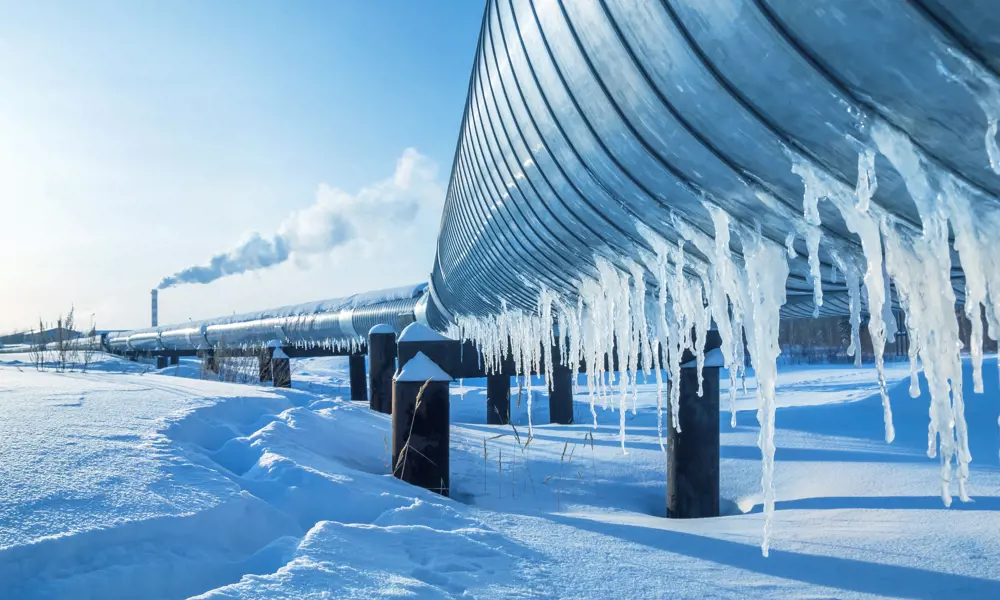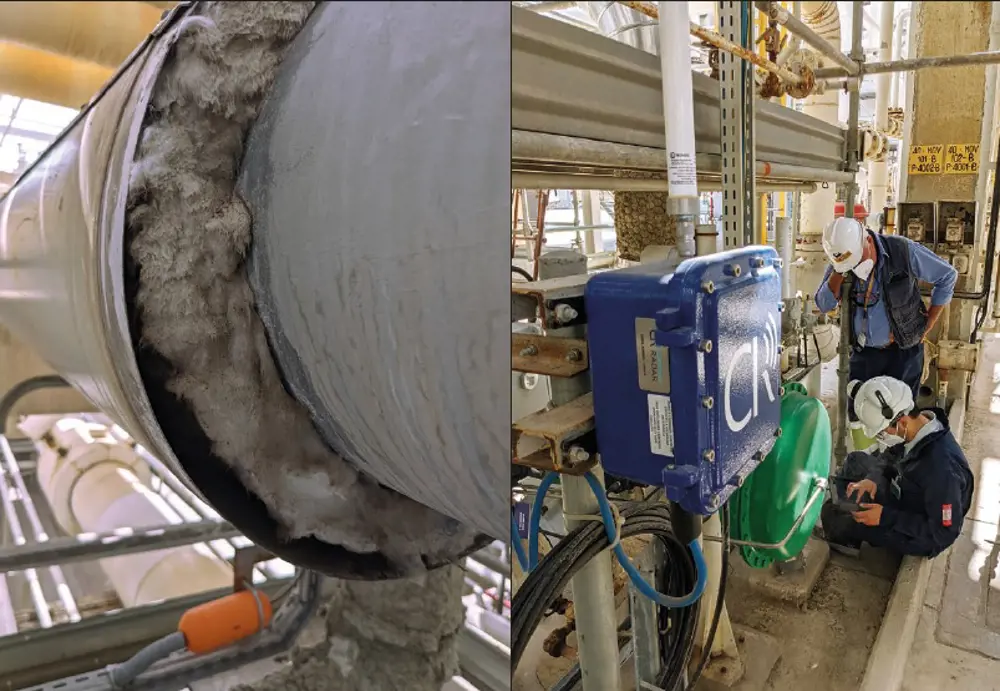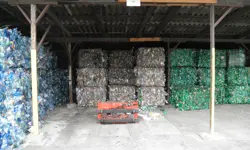
Averting hidden corrosion
Did you know?
Bacteria and dogs: which is the corrosion hero, and which is the villain?
- In recent years, millions of litres of oil have leaked from corroded pipelines, devastating ecosystems on land and at sea
- Corrosion can be caused by microorganisms living in oil sludge
- Along with a variety of higher-tech solutions, sniffer dogs can also detect hidden corrosion
The oil and natural gas that provide over 55% of the world’s energy are transported by enough pipeline to circle the Earth 30 times. Corrosion is a huge problem for all this infrastructure.
In 2006, a pinprick-sized hole, which gradually expanded to a diameter of less than two centimetres, was responsible for one of the worst oil spills to hit the tundra of Alaska’s North Slope. After 267,000 gallons of crude oil leaked from the corroded pipe at the Prudhoe Bay facility, oozing beneath the snow, government officials said it could take up to a decade for the tundra vegetation to return to normal. Experts believed the cause was corrosive bacteria, growing inside the pipe.
Two and a half years later, at the same facility, a high-pressure natural gas pipeline ruptured, launching pieces of mangled steel across the tundra. Luckily, neither loss of life nor environmental catastrophe took place as a result. Like the 2006 spill, the rupture was caused by corrosion, but this time, the culprit was not bacteria. Instead, moisture accumulating inside the layers of insulation and weatherproofing cladding around the pipe had caused the rupture – a phenomenon known as corrosion under insulation.
Corrosion, you might say, is to engineers what cancer is to doctors. Not literally, of course, but they do share a clutch of similar characteristics. Both can be triggered by the conditions in their surroundings. Both may be far advanced before detection. Both can sometimes be spotted by eye, but not always. If allowed to proceed unchecked, both can be destructive. The cost of remedying them when spotted late in their development is often high.
Corrosion and cancer also share one other feature: the benefit of early detection. Just as doctors have paid increasing attention to this, so have engineers – with good reason. The cost of corrosion to health and safety, to the environment, and to industry in monitoring and remedying it, is staggeringly large. Indeed, the economic cost of corrosion is staggering – estimated at more than £2 trillion annually worldwide, or 3% to 4% of global GDP (gross domestic product). Unsurprisingly, researchers are developing new measures to detect corrosion before its destructive consequences can take place.
Like the 2006 spill, the rupture was caused by corrosion, but this time, the culprit was not bacteria. Instead, moisture accumulating inside the layers of insulation and weatherproofing cladding around the pipe had caused the rupture – a phenomenon known as corrosion under insulation.
Corrosion: the bigger picture
🍝 What does lasagne have to do with corrosion?
Corrosion typically describes the degradation of metals, caused by chemical or electrochemical reactions with the surrounding environment. Rust is the most well-known form of corrosion: the oxidation product of ferrous metals, such as iron and steel, when exposed to oxygen and moisture.
However, there are many other causes of corrosion. For example, the corrosion that caused the catastrophic Alaska oil spill in 2006 was microbial. Bacteria had colonised the sludge that collected at the bottom of the pipe and formed a film with corrosive conditions. This is also a huge problem for the aviation industry, as bacteria can eat away at parts of an aircraft’s fuel tanks.
In marine environments, on the other hand, galvanic corrosion can cause major problems. This form of corrosion occurs when two different metals or alloys are partially in physical contact and immersed in an electrolyte such as seawater. It has afflicted Navy ships and the Statue of Liberty but can also be observed, somewhat less calamitously, if leftover lasagne is stored in steel cookware under aluminium foil.
Invisible destruction
One recently developed early detection technology is now finding a key role in the oil and gas industries. Paradoxically, its primary value is in detecting corrosion at sites where you might imagine it would be most easily spotted: exposed pipe work. Look at any oil refinery or petrochemical plant and one of its striking features will be a jumble of large, exposed tanks and tubes linked by interconnecting pipes that twist around and between them. You would think that corrosion here would surely be visible and easily discovered.
Not so. Although generally accessible, many pipes, pressure vessels and other components are insulated to keep the fluids inside at an optimum temperature. The insulation material is protected from the elements by a metallic casing. But such coverings are seldom wholly effective and some moisture, mostly rainwater, will find its way in. Any accumulation of moisture between the insulation and the surface of the innermost iron or steel pipes promotes corrosion, in the form of rust, that may become visible only when the insulating material is removed. The phenomenon, corrosion under insulation, accounts for some 60% of pipeline failures in the oil and gas industry alone. It can be tackled in several ways – and now mechanical engineer Prafull Sharma and his colleagues have added one more.
Having spent many years working for General Electric, Sharma was aware of the damage caused by corrosion. The model solution he had in mind was the nervous system of the human body. The sensory nerves that carry pain messages to the brain do more than signal the existence of such pain; they also pinpoint its location. What Sharma wanted was a system that would continuously monitor for corrosion in an industrial installation and tell the operator the site of any trouble.
During his PhD at Cranfield University, Sharma co-invented a technique to do just this, inspired by time-domain reflectometry, which is used by the telecoms industry to detect flaws in cables. In this technique, an electromagnetic pulse is sent along a suspect cable. If a fault is encountered, the pulse will be partially reflected; if not, it will be reflected back upon reaching the end. Knowing the originating pulse’s departure time, the arrival time of any partial reflections, and the velocity of the pulses, the operator can calculate where along the cable the fault is located.

Pipe work at refineries is one of the places badly affected by corrosion under insulation. It can become visible at the bottom surface of pipes, where moisture is most likely to accumulate
Detecting moisture, detecting rust
For rust to form, moisture must be present: so in a sense, water is a marker of rust. This means a technique able to signal the presence of one will highlight the likely existence of the other. Even if corrosion has not yet begun, being able to detect the key factor driving it – water – opens the way to preventive intervention.
Sharma’s invention, electromagnetic-guided radar, uses the same principle as time-domain reflectometry. It relies on a long, thin, flexible sensor laid along the surface of a pipe or storage vessel, beneath the overlying insulation. Its positioning is chosen to ensure that it runs wherever moisture is most likely to accumulate: on the lower surface of pipes, for example. One end of the sensor wire is connected to a control box that delivers the electromagnetic pulse. The wire acts as a waveguide (a structure used to direct waves along its length). As the pulse travels along the sensor, the presence of moisture anywhere along its length triggers the partial backward reflection of any pulse traversing it.
This partial reflection arrives back at the control box before the original pulse (which will have travelled on to the end of the wire and been reflected). Using the time difference between them allows the system to locate the moisture that triggered the reflection and therefore, the conditions that foster corrosion. If moisture is detected in several places on the sensor, it will generate multiple reflected signals. Data from the system is then transmitted to its operators for analysis, who can plan repairs if needed. It can even be used to predict the conditions that foster corrosion in a pipeline or plant. Armed with this understanding, operators can plan a programme of proactive maintenance to minimise their individual risks.
In new installations the sensor wires can be fitted to pipes and vessels during construction, and before the overlying insulation is applied. To use electromagnetic-guided radar in existing infrastructure, insulation must first be stripped off – a routine maintenance process. The frequency of these replacements varies according to the location of the plant, and other local circumstances. It may be as often as every three or four years, or as infrequently as once a decade.

Left: Moisture sensors are fitted underneath insulation and metal cladding. Right: A control box that sends data from connected sensors to plant workers © CorrosionRADAR
Now, this predictive corrosion monitoring tool has been patented and commercialised by a Cambridge-based company, CorrosionRADAR Ltd, of which Sharma is Chief Technology Officer and Co-Founder, along with Chief Executive Officer Chiraz Ennaceur and Chief Operating Officer Mehrdad Silatani. The company has already caught the attention of several agencies that advise corporations on the topic, and has worked with several international energy companies. Some 10 plants in locations from Europe to Thailand have installed the system.
Direct cost comparisons with other corrosion detection techniques are difficult to calculate, as most of them are used for spot checks if corrosion is already suspected. Electromagnetic-guided radar, by contrast, is a continuous monitoring system. Real-world data is still limited as none of the systems implemented have been in place for more than three years yet. But based on experience so far, Sharma talks of 65% overall cost savings in periods where electromagnetic-guided radar is used instead of conventional practices. An incidental benefit is that the technique will also detect leaks caused by corrosion inside a pipe or vessel.
Tackling corrosion under insulation
The simplest approach to detect corrosion under insulation is to remove cladding and insulation to expose the concealed surfaces at risk. Cutting windows through the insulation allows sections of pipe to be inspected. However, as scaffolding is needed to access some pipes and vessels, more extensive removal is time-consuming and prohibitively expensive. Although insulating materials are periodically replaced, at which point the pipework underneath can be viewed, these scheduled operations are not frequent enough to spot all instances of serious corrosion.
Several non-destructive testing approaches have a part to play in detecting corrosion under insulation, although there is no one perfect method to do so.
Ultrasound thickness testers can measure the thickness of a pipe or other structure in a specific location and detect internal as well as external corrosion. But this approach still requires insulation to be removed. Another very different form of ultrasound testing, guided wave, can be used to examine lengths of pipe but is thought to be more helpful in spotting internal defects than external corrosion.
Some types of radiography can be used to assess hidden pipes without removing the insulation. Here, X-rays, gamma rays or neutrons are fired at a material, which they travel through before being captured on a detector.
The same advantage holds for pulse eddy current inspection, which uses a direct current coil to induce a magnetic field in the pipe under inspection. Turning off the power leaves eddy currents in the pipe. The length of time that these take to dissipate is determined in part by the average thickness of the pipe’s wall. Sniffer dogs, thermography and neutron backscatter also have their advocates.
Although CorrosionRADAR’s tool is fairly distinctive commercially, the team is not the only one to have come up with using guided electromagnetic waves to detect corrosion. Between 2008 and 2012, researchers at Imperial College London’s Research Centre in Non-Destructive Evaluation pointed out that a metal pipe surrounded by a metal jacket of the kind often used to clad the insulating material constitutes a coaxial waveguide (meaning a waveguide made from two concentric metal cylinders). Microwaves, they suggested, could propagate through the insulation between the two metallic surfaces. They devised antennae, placed within the insulation, to generate microwaves. Although the method worked in laboratory trials, it was not taken forward commercially.
As often in non-destructive testing, there is no one technique that fits all circumstances. But many of the established methods are inspection techniques intended to offer a definitive diagnosis in one location at one time. Electromagnetic-guided radar provides a way to continuously monitor extensive networks of pipes and vessels and alert workers not only to the existence of corrosion, or the risk of it, but its location. Other methods can then be used to inspect the area of concern in more detail. All told, perhaps this physiology-inspired technique can, in tandem with a toolkit of others, help to keep the blood vessels of today’s energy system safely flowing, leak-free.
***
This article has been adapted from "Averting hidden corrosion", which originally appeared in the print edition of Ingenia 90 (March 2022).
Keep up-to-date with Ingenia for free
SubscribeRelated content
Materials

What are aerogels?
Among some of the lightest known solid materials, aerogels, formed by removing liquid from gels, have many uses ranging from catalysts and sensors, to being used on NASA missions.

Recycling household waste
The percentage of waste recycled in the UK has risen rapidly over the past 20 years, thanks to breakthroughs in the way waste is processed. Find out about what happens to household waste and recent technological developments in the UK.

Diamond technology: beyond hardness
Diamond is being used in an increasing variety of industrial and technological applications, due to other properties in addition to its hardness. The UK is home to a wide range of diamond research, development and synthetic diamond production activities.

A lot more than lubrication
The control of friction and wear in mechanical systems by lubrication and surface engineering has led to safer, faster transport as well as medical innovations. Ian Hutchings FREng, GKN Professor of Manufacturing Engineering at the University of Cambridge, highlights the progress and some failures of the important discipline of tribology.
Other content from Ingenia
Quick read

- Environment & sustainability
- Opinion
A young engineer’s perspective on the good, the bad and the ugly of COP27

- Environment & sustainability
- Issue 95
How do we pay for net zero technologies?
Quick read

- Transport
- Mechanical
- How I got here
Electrifying trains and STEMAZING outreach

- Civil & structural
- Environment & sustainability
- Issue 95